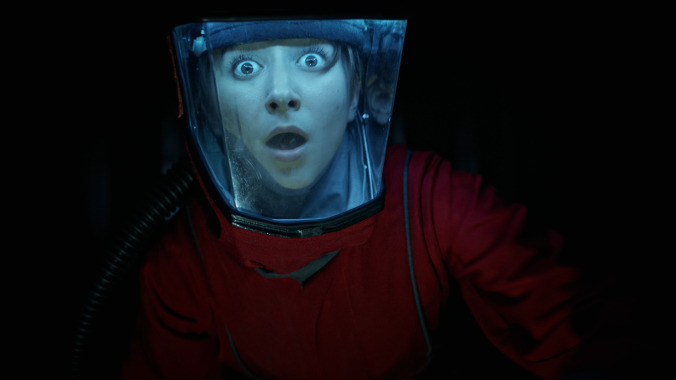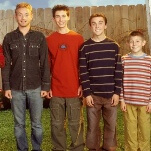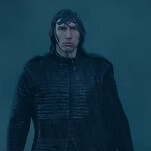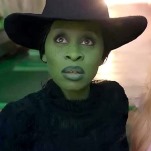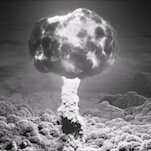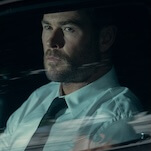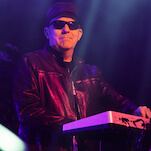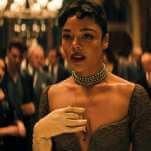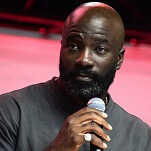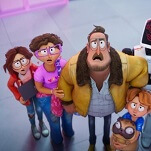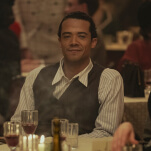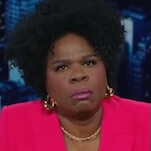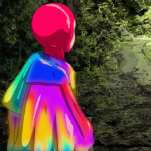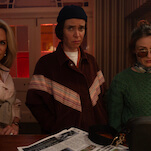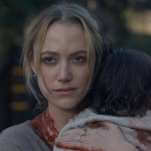Featuring retro-futurist credits that make it look like X-Files for the digital age, Dark/Web follows a group of twentysomethings who reunite to investigate when one of their old friends reaches out to each of them individually via email, only to have seemingly disappeared. That friend, Molly (Noemi Gonzalez), has sent mysterious short stories to each of the three former besties: lovelorn unemployed journalist Ethan (Brian Elerding), upbeat but prickly YouTuber Sam (Lana McKissack), and depressed teacher James (Michael Nardelli). Those stories are meant to negatively comment on some aspect of each of their lives, in ways that push them all to try and locate their old friend, even traveling to her last residence to track her down. What they find there isn’t Molly, but rather a stranger with a worrying story, one that could put all their lives in danger.
Subtlety is not the show’s strong suit. Dark/Web is the kind of series where a character listens to talk radio in which the host says, “Everything bad in the world right now can be traced back to the dark web,” and we’re supposed to take it at face value. Such bluntness can be wielded effectively, but more often it highlights the lack of artful subtext in the series. The anthology stories are intended to provide some sort of insight or clever reference to the lives of Molly’s would-be rescuers, but the link is either obnoxiously broad or utterly arbitrary. (After Ethan finishes his story, about a man who drives for a ride-share company whose app starts forcing him to commit violent crimes against his passengers, the journalist mutters, “I was about to start Lyft next week.”)
If the standalone stories themselves were better it wouldn’t be as much of a problem, but by and large they come across like limp installments of The Outer Limits, with the same old-school basic cable production values. There’s charm in such an aesthetic—some of us have nostalgic memories of those series—but it’s not particularly impressive television. Each one is boilerplate sci-fi/supernatural hokum, with predictable results: A woman whose attention to upping her follower count on a social-networking site learns there may be an awful downside to her newfound attention; a man who receives a black-market heart transplant starts to suspect the previous owner’s psyche has hitched a ride; an awkward tryst between two people who meet online turns out to be for something far darker than sex; and so on. Some aren’t even fully realized narratives, more concepts in search of a reason for existing, like a story about a woman in a Hazmat suit escaping the site of an infection, only for it to be revealed as a VR simulation she prefers to real life. The end.
The same creative team as the under-the-radar Netflix cult film Circle is responsible for this project, and they struggle to expand their vision to an eight-episode series. Whereas that Twilight Zone-esque parable was sharply told and executed with lo-fi verve, the seams are showing in these 30-minute installments (with two episodes that overstay their welcome at more than double that length). The wraparound narrative involving the hunt for Molly is competently shot, but many of the anthology installments are blandly staged and either under- or over-lit, suggesting a run-and-gun project just trying to make its shooting days. Co-creators Tim and Michael Nardelli, along with several of their fellow producers, wear a lot of hats here (the latter, in addition to his performance as James, is a writer, director, editor, and credited with the graphic design and title art, just to give one example). Again, that’s a hallmark of indie productions, but it often means people are performing jobs at which they might not be the best suited, and it shows in the final product.
The signs of life come through in minute ways: A wry sense of humor that occasionally bubbles up, such as a scene where a guy in an institution absolutely freaks out when confronted with a cell phone, screaming, “I don’t wanna make a call!”—then after a beat of silence, follows it with a low-key, “I’m not doing great, you know.” And several performances are solid, especially Gonzalez as Molly, whose charisma shines through even the dingiest locations. There’s a wealth of cameos and one-offs from character actors like Robert Davi and Siobhan Hogan; Buffy fans will realize they’re probably in like company, as Clare Kramer, Nicholas Brendon, and Julie Benz all pop up. But Dark/Web ultimately has little to recommend it beyond small pleasures and the charm of seeing the tropes and style of second-tier cable TV anthology stories reworked for the modern age. Technology may be essentially evil in this show’s perspective, but it also allowed for such a shaggy dog of a series to receive widespread viewing on one of the biggest streaming services in the country.
